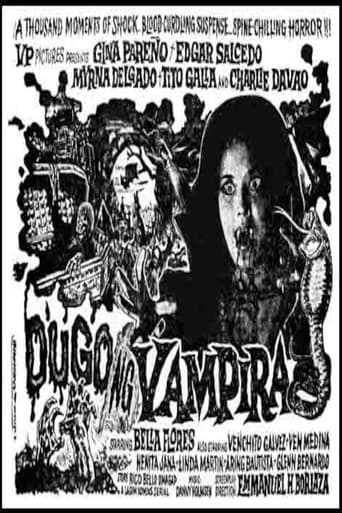Andrew Leavold
As with much of the Philippines' pre-Eighties cinema, very few vampire films from the Sixties have survived. Thankfully there are two bona fide masterpieces of Pinoy horror directed by Gerry de Leon, The Blood Drinkers and Curse Of The Vampires. Both were constructed from the ground up as export-friendly titles, filmed in Technicolor and dubbed into English using the actors' own voices. And then there's Dugo Ng Vampire, a product of a stagnating studio system, and it shows; Vera Perez Pictures was an offshoot of Sampaguita Films which until the early Sixties was part of the Big Three's monopoly over Filipino cinema, along with LVN Pictures and Premiere Productions. Dugo… is a prime example of the local industry's glaring limitations: patchy live sound, an unwieldy regulation 110-minute running time, a masala of melodrama and comedy based on a pre-branded komik series, and a dreadful transfer from a scratched, rat-assed black and white 35mm print. That the film still exists, however, is a miracle in itself; the fact it's a decent populist Pinoy horror from the Sixties is, for the most part, pure cream.Dugo Ng Vampira's hand-scribed credits flash over an opening that's vintage Universal horror: the town's landed gentleman and unrepentant vampire Angustia has just feasted on a young female victim and is now pursued by an angry mob of torch-carrying villagers. Cornered in the grounds of his villa, Angustia is staked through the heart with a sharpened cross and left to die alone in agony. With the sound of a howling wolf in the distance, he is tended to by his distraught sweetheart, who removes the cross and buries him underneath it. Being mortal, she is also carrying the vampire's children – twins, one good and one inherently evil – and after her mother is thrown down her stairs by an unseen force (linked to the cobra curled around the vampire's grave marker!), she leaves one of the babies, flees the village with the other child, and heads in a trance directly for the sanctuary of Angustia's villa.A decade passes, and the mother grows suspicious of her remaining child's true nature. She catches the girl Lucinda in a cave talking to a cobra and bat – and the bat, a bizarre sock puppet contraption with wings, is talking back! The girl plumps up quickly into a brazen teenaged hussy (Gina Pareno), unaware of the existence of her twin sister Rosario (also Pareno, without the excessively vampish makeup, puffy hair and go-go boots). Meanwhile the mouldered corpse of their father rises out of the soil, transforms into his suave former self, then disappears in a flapping of bat wings and reappears at the villa along with his last victim, unlocked from her cobra shell. Angustia and his new bride are keen to teach Lucinda the finer points of her vampiric legacy ("We need blood," they hiss, "HUMAN blood…"), and take her for a flying visit around the craggy countryside looking for victims. It's here the film's rudimentary special effects – dissolves, jump cuts, miniatures for the Villa exterior – take a quantum leap: Lucinda complains of being tired, and suddenly the cabal split into two mid-air in typical Manananggal fashion, their fanged top halves continuing to soar while the bodies gently land. A simple optical effect, and positively prehistoric by today's standards, but crudely and eerily effective.Naturally the plaited, seminary-going Rosario is mistaken for her bloodsucking sister, and her beloved Victor becomes fiercely protective of her; once the angry villagers notice she is not scared of a crucifix but the "other" Rosario is, the hunt is on for a neighborhood vampire. Victor's deceitful, treacherous Lothario brother Rufo arrives from the city and he too has eyes for Rosario; Rufo's plan is to trap her in his house until she falls in love with him, but then the equally duplicitous Lucinda, posing as Rosario, seduces him over to the Other Side. The scenario now brother against brother, mother against child, as both families fight to save what Goodness is left within them.More pronounced than ever is the presence of Evil – in this instance, vampirism - as a dramatic rip in the fabric of everyday, God-fearing, family-bound normalcy. The film's core rests upon a triumvirate of dualistic relationships, one representing Good, or at the very least temporarily lost and potentially salvageable, and the other Evil: unwed mother and vampire Angustia, daughters Rosaria (Rosary, perhaps?) and Lucinda (Lucifer?) and brothers-at-war Victor and Rufo. The protracted finale sees not only Victor cornered and forced to kill his sibling (in a neat twist, with a conch shell!), but the mother to sacrifice her Bad Seed. In Dugo's intensely moral, necessarily komik page black-and-white universe, Evil is ultimately vanquished and the wayward are brought back to God's bosom, but at a heavy price.At times you'd be forgiven for thinking Dugo… is a Bollywood remake of a Mexican vampire film: melodramatic, a fusion of Asian and Hispanic family-centricity, tarnished and years-weary, and entertaining in an arched, eccentric way. In its favor it's not nearly as cloying and sentimental as it could be, there are no musical numbers to spoil the atmosphere, and the regulation comic relief from a mugging German Moreno – effeminate leader of a group of tourists stranded overnight at Angustia's villa - is kept to a minimum, as is the teen soap angle (if Vilma Santos or Nora Aunor were the lead, God help us...). OK, so comparisons are mean, and so what if Dugo Ng Vampira is no Curse Of The Vampires? Sometimes it's good to turn a blind eye to the Ugly Duckling's smarter and prettier classmates and welcome them home as a lost child, sorely missed and never to be forgotten.
